Women in Agriculture 'Be Your Best Self' 2020-2021 pilot evaluation report
This report outlines the main findings of an evaluation of the ‘Be Your Best Self’ training pilot 2020-2021, funded by Scottish Government through the Women in Agriculture Development Programme.
5. Survey results
This section presents the results from the pre-course and post-course questionnaires completed by participants from cohorts 2-4 of the ‘Be Your Best Self’ training pilot.[5]
The questions were designed to measure the success of the pilot against the intended course outcomes (see page 7).
These are the main findings from both surveys:
- Respondents felt more optimistic about their future in agriculture after completing the course. Whilst in the first questionnaire, the most common response was ‘I feel slightly positive about my future in agriculture’ (52%), after the course the majority of respondents felt ‘optimistic’ (88%) about their future in agriculture.
- Respondents had clearer ideas about their future in agriculture after completing the course. Before the course, most respondents said they have ‘a few ideas or plans’ (67%) and a quarter said they lacked or had no clear plan or ideas (25%). Following the course, half of respondents said they have ‘clear’ ideas (50%) about their future in agriculture and half stated that they have ‘a few ideas or plans’ (50%).
- Before the course only 13% of participants were confident that they have useful skills, strengths and experiences when thinking about working in agriculture, and one in five were ‘not sure’ (20%). After the course, over half stated that they were ‘confident’ that they have useful skills, strengths and experiences (63%) and none were unsure.
- The majority of respondents stated that the course had a ‘positive impact’ on their confidence in their own skills, strengths and experiences (98%).
- Before the course, over a third of respondents felt ‘unsure’ about going to agricultural events, meetings or training (35%). After the course, the majority of respondents stated that they would feel more confident about taking part in agricultural events (78%) and signing up for further training or employment opportunities (88%).
- Respondents felt more connected to other women in agriculture after taking part in the course. In the first questionnaire, 27% said they had good connections to other women in agriculture, 47% were ‘unsure’ and 25% said they did not have good connections to other women in agriculture. Afterwards, the majority of respondents said they had good connections to other women in agriculture (88%).
- Lastly, all who responded to the post-course questionnaire stated that they thought the course would be beneficial to other women in agriculture.
5.1 Their future in agriculture
- In the pre-course survey, the majority of respondents said that they felt either ‘slightly positive’ (52%) or ‘optimistic’ (40%) about their future in agriculture (see Figure 1).
- A smaller number felt either ‘less positive’ or ‘negative’ (8%).
- When asked how they feel about their future in agriculture after they had completed the training, the majority of respondents felt optimistic (88%). A smaller number felt slightly positive (12%) and none felt less positive or negative.
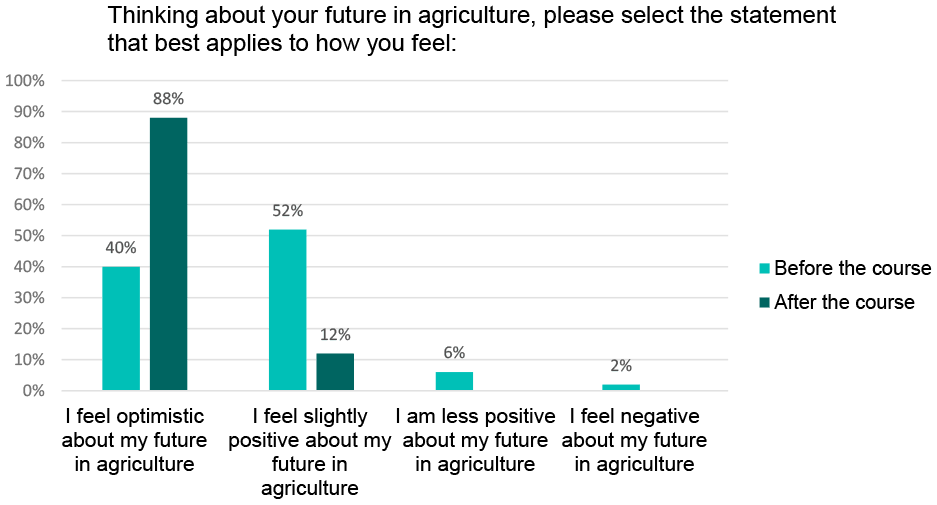
- In the pre-course survey, most respondents said they have ‘a few ideas or plans’ about their future in agriculture (67%). A small number had ‘clear’ ideas (7%), whilst 16% said they ‘lack ideas or plans’ and 9% said they ‘have no clear plan or ideas’ (see Figure 2).
- After the course, over a third of respondents said they now have ‘clear’ ideas (37%) about their future in agriculture and over half stated that they have ‘a few ideas or plans’ (63%). None stated that they lack or have no clear plan or ideas.
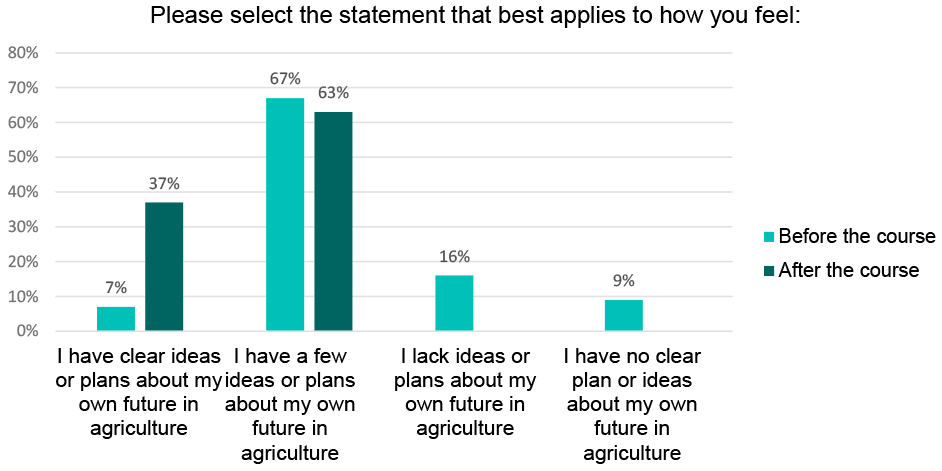
5.2 Confidence, skills and experience
- In the pre-course survey, when asked to think about their own skills and experiences when working in agriculture, over half (64%) respondents said ‘I think I have useful skills, strengths and experiences’ (see Figure 3).
- A smaller number were ‘confident’ that they do (13%). One in five said they were ‘not sure’ (20%) and 4% were ‘not confident’.
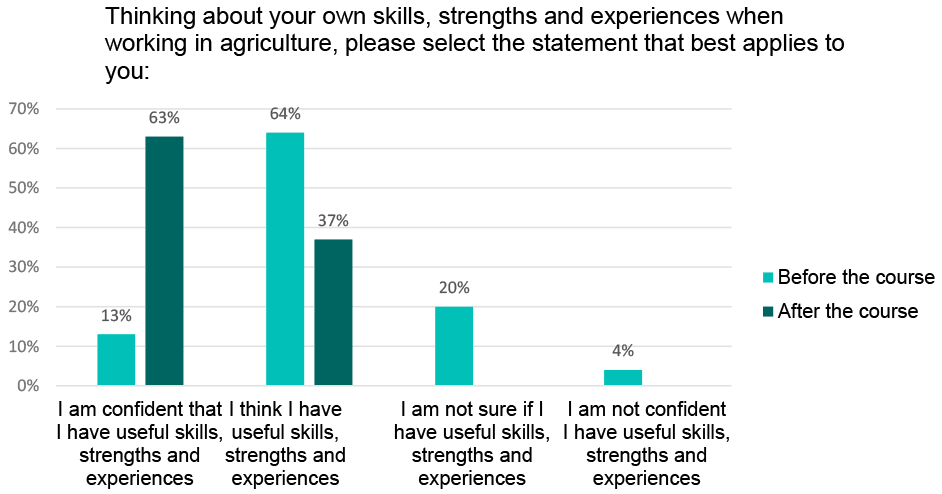
- After the completing the training, over half (63%) of respondents stated that they were ‘confident’ that they have useful skills, strengths and experiences. The rest stated ‘I think I have useful skills, strengths and experiences’ (37%). None selected ‘not sure’ or ‘not confident’.
- When asked about the impact of the training on their confidence in their own skills, strengths and experiences, the majority of respondents stated that it had had a ‘positive impact’ (86%), with 12% selecting ‘slightly positive’ and a minority (2%) saying it had had ‘no impact’ (see Figure 4).
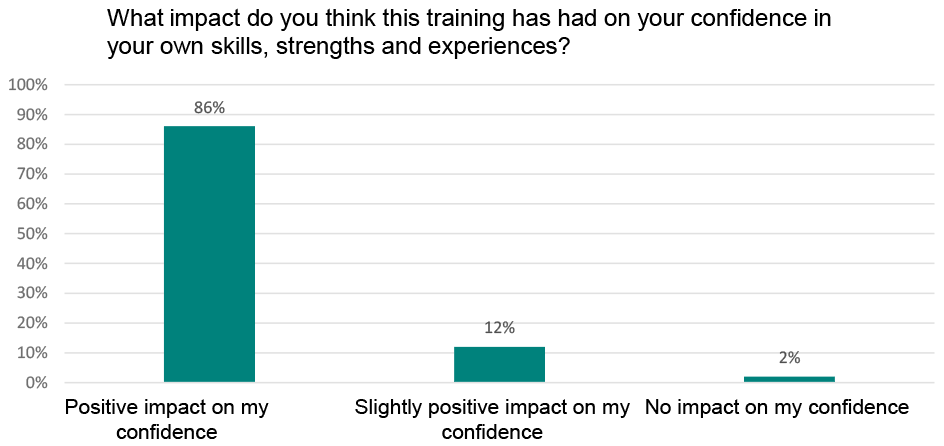
- In the pre-course survey, when asked if they feel confident about raising issues or concerns about the way the business is run during their day-to-day life, over a quarter of respondents were ‘confident’ (27%), whilst nearly a third were ‘slightly confident’ (29%), and a further quarter (25%) were ‘unsure’ or did not feel confident (see Figure 5).
- Almost a third (31%) of respondents to the pre-course survey felt like their views and opinions were acted on, whilst one in ten (11%) did not (see Figure 6).
- Almost a third (31%) felt that they have a say in financial decision making in the business they were part of, whilst almost a tenth (9%) did not.
- Over a tenth of respondents stated that they ‘would like a greater say in decision making in the business’ (11%).
- Almost a third (31%) stated this was ‘Not applicable’.
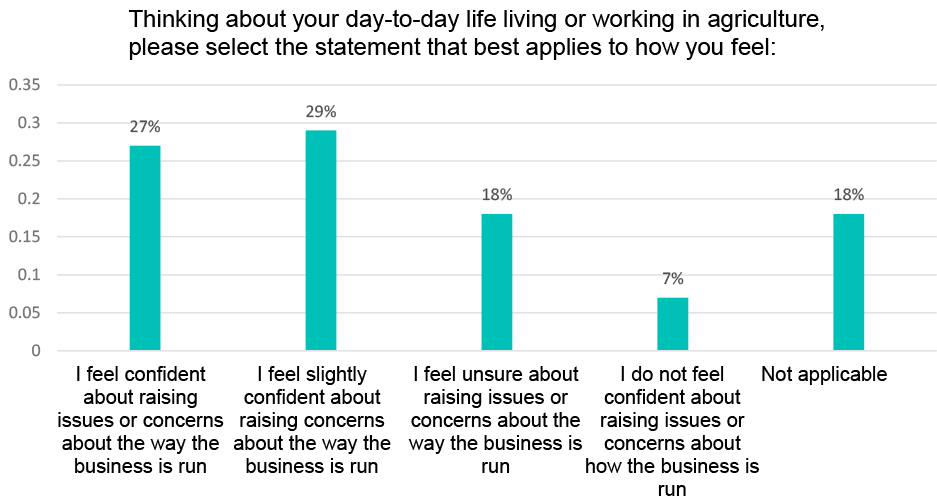
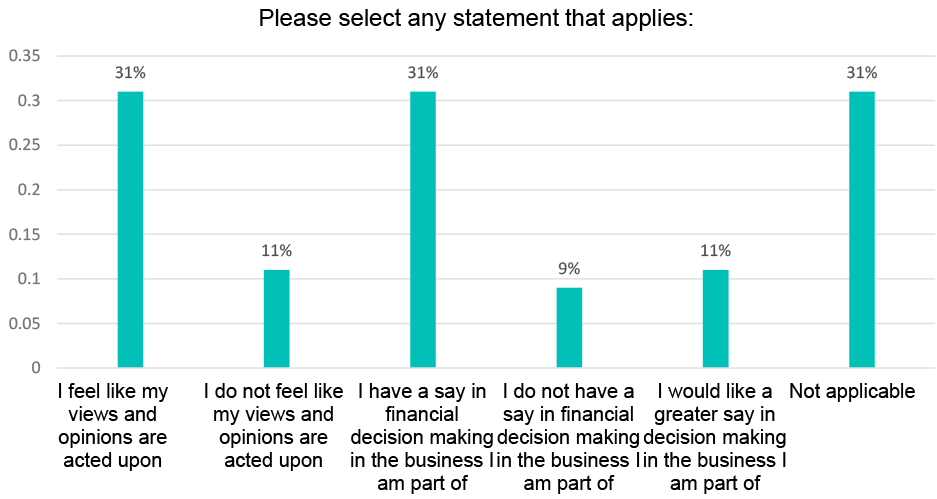
5.3 Agricultural events and meetings
- Respondents to the pre-course survey were most likely to feel ‘unsure’ about going to agricultural events, meetings or training (35%). A smaller number felt ‘confident’ (24%) or ‘slightly confident’ (28%) and over a tenth (13%) did not feel confident (see Figure 7).
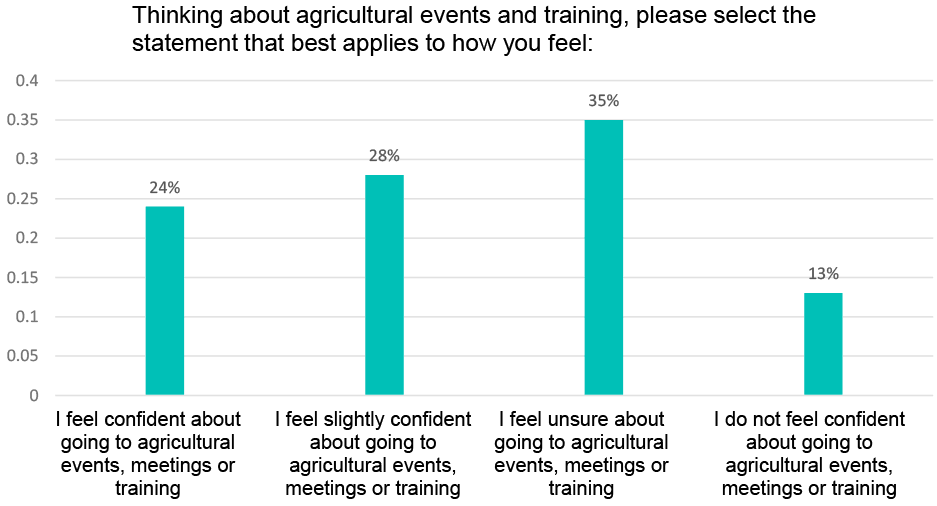
After completing this training, the majority of respondents stated that they would feel more confident about doing the following (see Figure 8):
- signing up for further training or employment opportunities (88%);
- taking part in agricultural events (78%);
- raising issues or concerns about the way the business is run (70%);
- making sure their views and opinions were acted on (62%);
- and having a say in financial decision making in the business (52%).
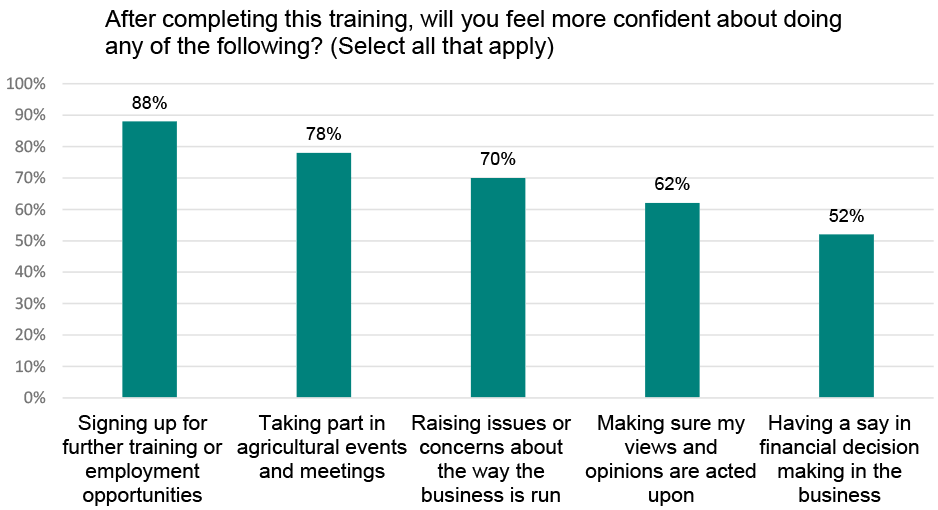
5.4 Connections to other women in agriculture
- In the pre-course survey, when asked about their relationship with other women in agriculture, over a quarter of respondents said they had good connections to other women in agriculture (27%). Almost half were unsure (47%) and over a quarter (25%) said they did not have good connections to other women in agriculture
- When asked about their relationship with other women in agriculture now that they had completed the course, the majority of respondents said they had good connections to other women in agriculture (88%), whilst a fifth remained unsure (10%). Only 2% said they did not have good connections (see Figure 9).
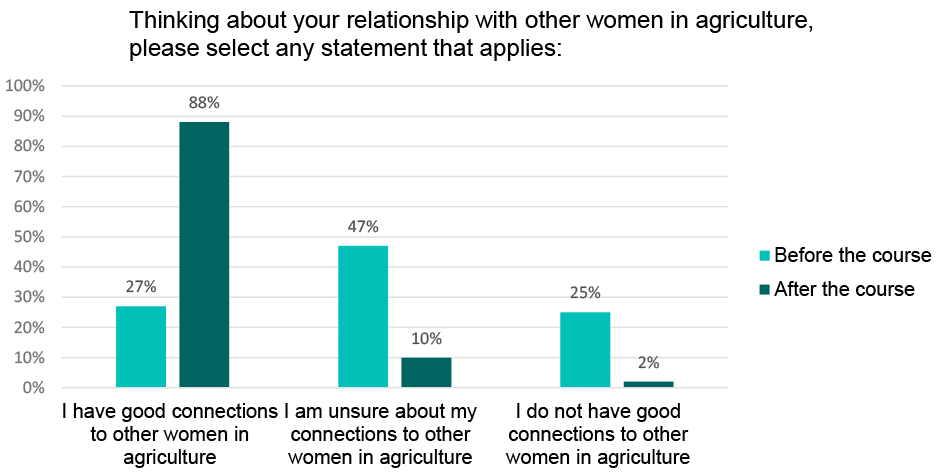
5.5 What respondents hoped to get out of the course
- When asked about the main thing they hoped to get out of the course, respondents were most likely to say: confidence and focus, making connections, a support network, career direction and a plan for the future.
- Further responses included relevant skills such as agricultural knowledge, running a business, managing staff.
Examples
- ‘A greater sense of my role on the farm for now and in the future. The ability to articulate in a non-confrontational manner what I would like my role to involve / not involve. The confidence that I might have some knowledge / transferable skills relevant to the business. The feeling that I’ve contributed to farm life and helped to make a difference, rather than feeling that I don’t really have a role.’
- ‘To be more confident when communicating with others in my industry. Although women are very often very involved practically, it is usually the men who make the decisions about buying the rams.’
- ‘My main objective for this course is to become more confident, particularly in social/networking situations such as shows and meetings but also within my day to day work.’
- ‘I hope to increase my confidence and try to work out where I fit within the farm business. […] I am struggling to find exactly where I fit in whilst also juggling a young family and my own business. I am hoping the course will help me to see a way forward and be more positive for the future.’
5.6 Views on the training course
- Respondents were asked to rate how useful they found different parts of the training on a scale of 1 to 5 (1 ‘Not at all useful’ to 5 ‘Extremely useful’)
- The average scores were as follows: ‘The opportunity to connect with other women in agriculture’ (4.8), ‘A chance to build confidence in my skills, strengths and experiences’ (4.6) and ‘The support to put myself forward and take on further opportunities’ (4.6) (see Figure 10).
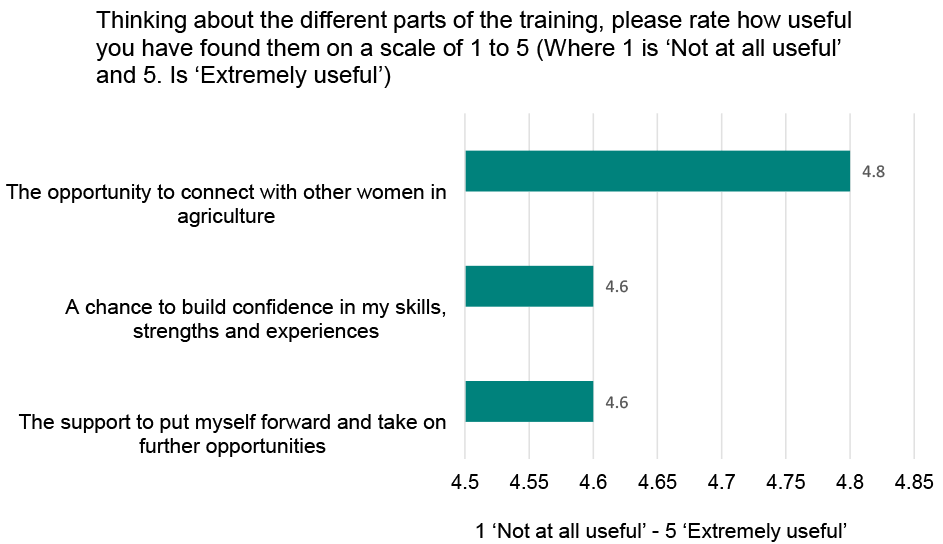
- When asked to rate different aspects of the course on a scale of 1 to 5 (1 ‘Very poor’ to 5 ‘Excellent’), respondents rated all aspects highly (see Figure 11).
- The average scores were as follows: welcome box (4.9), individual coaching (4.8), course facilitators (4.8), guest speaker (4.8), workshop (4.7), digital platform (4.7), networking (4.7) and the course materials (4.6).
Thinking about the course as a whole, and your expectations before you began, was the training relevant to your needs?
- The majority of respondents felt that the course had been relevant to their needs, even if they had not known what to expect.
Examples
- ‘I had no clue before signing up what it was about. I did not really know my needs before the training as I had never looked at myself. The training has allowed me to identify these needs to progress further.’
- ‘Yes. I wasn’t sure what to expect but the course was so cleverly designed and aligned to what I needed and really went on a journey of learning more about myself and the things that I can change as well as meeting lots of other women, getting inspiration and tools to help breakdown problems and plan things out.’
- ‘It definitely exceeded my expectations. It also gave me the opportunity to take some time out and review where I am. The most relevant and useful training that I’ve done in recent years.’
- ‘This course was about finding your voice by looking inside and opening up. I found this really valuable, and I can apply the things I have learnt not only to myself, but my relationships as well as giving me the confidence to start a small rural business. I would say that the support from the other participants forms a big part of the success of the course too.’
What skills has this course helped you to develop?
- Respondents stated that the course has helped them to develop their skills in communication, self-reflection, planning (e.g. mind maps) and networking.
- They also indicated that the course has given them practical tools, e.g. in being aware of their own thought processes and behaviour, recognising their strengths or weaknesses, dealing with stressful situations and feeling more confident.
Examples
- ‘The course has given me the confidence to make bigger decisions, take more calculated risks and really be excited for the future without fearing what others might think or worrying about getting things wrong.’
- ‘Greater self-awareness and self-reflection. I’m hoping the ability to be a better communicator. It’s helped me to develop my networking skills and the ability to recognise that I actually already have lots of skills!’
- ‘Confidence to believe in my own abilities, how better to deal with difficult situations and to assert my own needs.’
- ‘I feel much more confident in approaching other people within agriculture to gain information and collaborate with. I have been able to take a strategic look at what my farm business needs to develop and move forward.’
All respondents (100%) stated that they thought the course would be beneficial to other women in agriculture (see Figure 12).
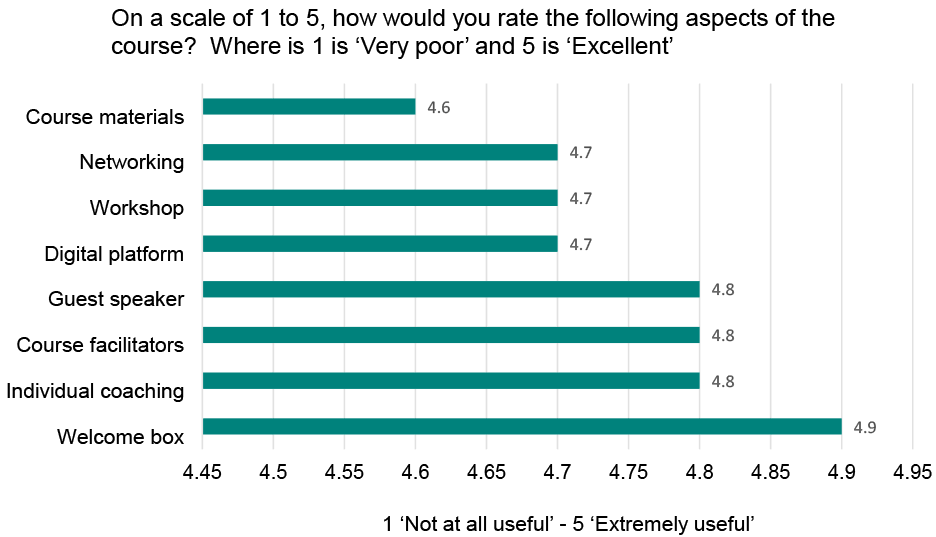
5.7 Demographics
- The majority of respondents were aged 30-49 (62%). 15% of respondents were aged 18-29 and a further 25% were aged 50 and over.
- Respondents were most likely to live or work on a farm (64%), whilst a smaller number stated that they live or work on a smallholding (15%) or croft (7%) and a further 16% selected ‘not applicable’.
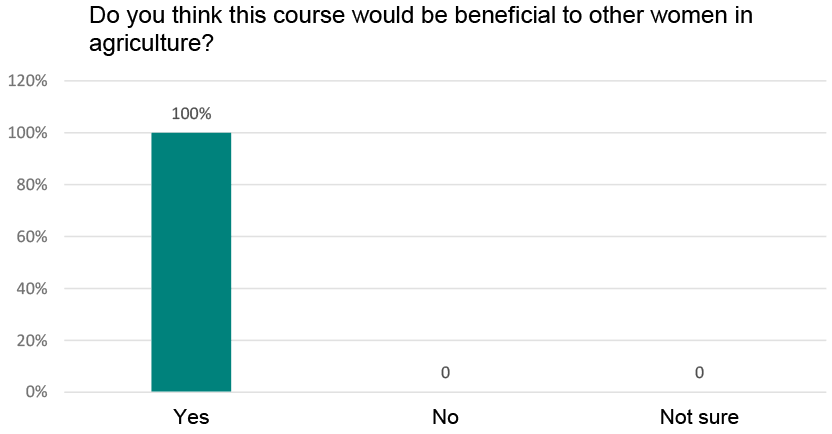
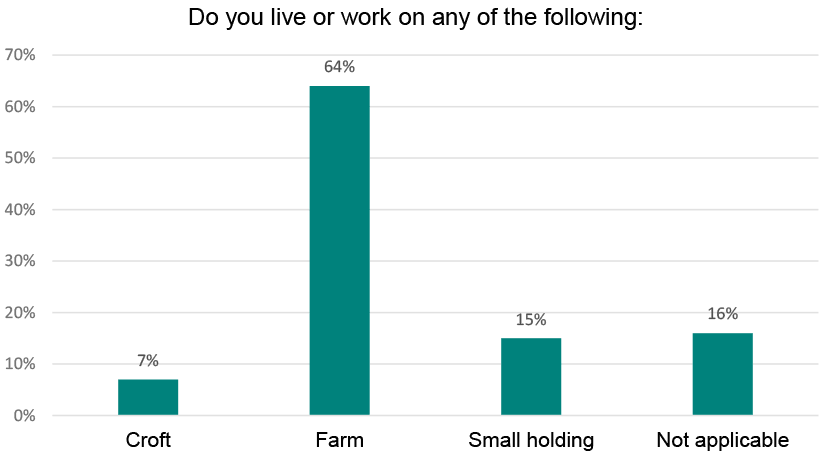
Contact
Email: socialresearch@gov.scot
There is a problem
Thanks for your feedback